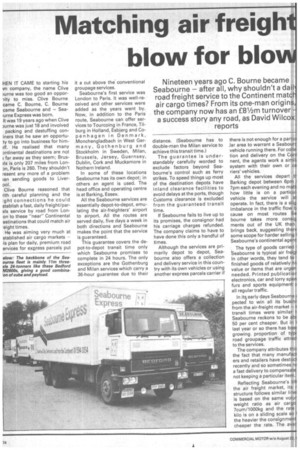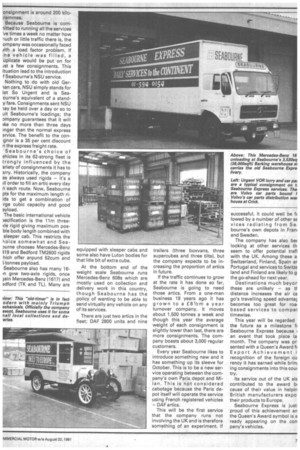Matching air freight blow for blow
Page 52

Page 53

If you've noticed an error in this article please click here to report it so we can fix it.
Nineteen years ago C. Bourne became Seabourne — after all, why shouldn't a daill road freight service to the Continent match air cargo times? From its one-man origins, the company now has an f81/2m turnover a success story any road, as David Wilcox reports
HEN IT CAME to starting his vn company, the name Clive )urne was too good an opporlity to miss. Clive Bourne came C. Bourne, C. Bourne came Seabourne and — Seaurne Express was born.
It was 19 years ago when Clive 3urne was just 18 and involved packing and destuffing conmars that that he saw an opportuty to go into business for himIf. He realised that many Dntinental destinations are not far away as they seem; Brusfls is only 207 miles from Lonan, Paris is 260. They shouldn't resent any more of a problem Ian sending goods to Liverool.
Clive Bourne reasoned that !ith careful planning and the ght connections he could stablish a fast, daily freight/parels service by road from Lonon to these "near" Continental estinations that could match air -eight times.
He was aiming very much at stablished air cargo markets — is plan for daily, premium road ervices for express parcels put it a cut above the' conventional grou page services.
Seabourne's first service was London to Paris. It was well-received and other services were added as the years went by. Now, in addition to the Paris route, Seabourne can offer services taTourcoing in France, Tilburg in Holland. Esbjerg and Copenhagen in Denmark, .Monchengladbach in West Germany, Gothenburg and Stockholm in Sweden, Milan, Brussels, Jersey, Guernsey, Dublin, Cork and Muckamore in Nothern Ireland.
In some of these locations Seabourne has its own depot; in others an agent is used. The head office and operating centre is at Barking, Essex.
All the Seabourne services are essentially depot-to-depot, emulating the air-freighters' airport to airport. All the routes are served daily, five days a week in both directions and Seabourne makes the point that the service is guaranteed.
This guarantee covers the depot-to-depot transit time only which Seabourne promises to complete in 24 hours. The only exceptions are the Gothenburg and Milan services which carry a 36-hour guarantee due to their distance. (Seabourne has to double-man the Milan service to achieve this transit time.) The guarantee is understandably carefully worded to exclude factors beyond Sea bourne's control such as ferry strikes. To speed things up most of the destination depots have inland clearance facilities to avoid delays at the ports, though Customs clearance is excluded from the guaranteed transit time.
If Seabourne fails to live up to its promises, the consignor had his carriage charges refunded. The company claims to have to have done this only a handful of times.
Although the services are primarily depot to depot, Seabourne also offers a collection and delivery service in this country with its own vehicles or using another express parcels carrier if there is not enough for a partic Jar area to warrant a Seabourr vehicle running there. For colla tion and delivery on the Cod nent, the agents work a simili system with their own or ca riers' vehicles.
All the services depart th Barking depot between 6pm 1 7pm each evening and no matt+ how little is on a particul vehicle the service will St operate. In fact, there is a slig imbalance in the traffic flow b cause on most routes Se bourne takes more consig ments out of the UK than brings back, suggesting therE some scope for harder selling Seabourne's continental agent
The type of goods carried I 'Seabourne is typical air freigl In other words, they tend to finished goods of relatively value or items that are urgen needed. Printed publicatior electronics, car and lorry span furs and sports equipment E all regular traffic.
In its, early days Seaboume pected to win all its busins from the air-freight market —1 transit times were similar t Seabourne reckons to be abt 50 per cent cheaper. But in 1 last year or so there has beei growing proportion of typi road groupage traffic attraci to the services.
The company attributes this the fact that many manufaci ers and retailers have destocl recently and so sometimes nf a fast delivery to compensate not keeping a particular item.
Reflecting Seabourne's till the air freight market, its r structure follows similar linei is based on the same volur weight ratio as air cargo 7cum/1000kg and the rate kilo is on a sliding scale so 1 the heavier the consignment cheaper the rate. The aver onsignment is around 200 kiloIrammes.
Because Seabourne is corn-lifted to running all the services ire times a week no matter how -uch or little traffic there is, the ompany was occasionally faced iith a load factor problem. if ne vehicle was filled, a uplicate would be put on for Ast a few consignments. This ituation lead to the introduction f Seabourne's NSU service.
Nothing to do with old Ger-Ian cars, NSU simply stands for lot So Urgent and is Seaourne's equivalent of a standy fare. Consignments sent NSU lay be held over a day or so to uit Seabourne's loadings; the Dmpa ny guarantees that it will ike no more than three days inger than the normal express 3rvice. The benefit to the congnor is a 35 per cent discount n the express freight rate.
Seabourne's choice of ahicles in its 62-strong fleet is trongly influenced by the ariety of consignments it has to 3rry. Historically, the company as always used rigids — it's a ill order to fill an artic every day n each route. Now, Seabourne pts for the maximum length riids to get a combination of rge cubic capacity and good ayload.
The basic international vehicle aecification is the 11m threede rigid giving maximum posble body length combined with sleeper cab. This restricts the rioice somewhat and Seaaurne chooses Mercedes-Benz $19 and Bedford TM2600 rigids hich offer around 52cum and 5 tonnes payload.
Seabourne also has many 16n gvw two-axle rigids, once lain Mercedes-Benz (1617) and 3dford (TK and TL). Many are equipped with sleeper cabs and some also have Luton bodies for that litle bit of extra cube.
At the bottom end of the weight scale Seabourne runs Mercedes-Benz 608s which are mostly used on collection and delivery work in this country, though Seabourne has the policy of wanting to be able to send virtually any vehicle on any of its services.
There are just two artics in the fleet; DAF 2800 units and nine trailers (three boxvans, three supercubes and three tilts), but the company expects to be increasing the proportion of artics in future.
If the traffic continues to grow at the rate it has done so far, Seabourne is going to need those artics. From a one-man business 19 years ago it has grown to a £81/2m a year turnover company. It moves about 1,500 tonnes a week and though this year the average weight of each consignment is slightly lower than last, there are more consignments. The company boasts about 3,000 regular customers.
Every year Seabourne likes to introduce something new and it has something up its sleeve for October. This is to be a new service operating between the company's own Paris depot and Mila n. This is not considered cabotage because the Paris depot itself will operate the service using French registered vehicles — DAF artics.
This will be the first service that the company runs not involving the UK and is therefore something of an experiment. If
successful, it could well be fc lowed by a number of other SE vices radiating from Se bourne's own depots in Fran' and Sweden.
The company has also bet looking at other services th seem to offer potential ire with the UK. Among these a Switzerland, Finland, Spain ar Portugal and services to SwitzE land and Finland are likely to g the go-ahead for next year.
Destinations much beyor these are unlikely — as distance increases the air ca go's travelling speed advantac becomes too great for mai based services to compel timewise.
This year will be regarded the future as a milestone f( Seabourne Express because an event that took place la month. The company was pr, sented with a Queen's Award f( Export Achievement i recognition of the foreign cu rency it has earned while brinj ing consignments into this coui try.
Its service out of the UK ale contributed to the award la' cause of their value in helpin British manufacturers expo their products to Europe.
Seabourne Express is just' proud of this achievement an the Queen's Award symbol is a ready appearing on the con pany's vehicles.




























































